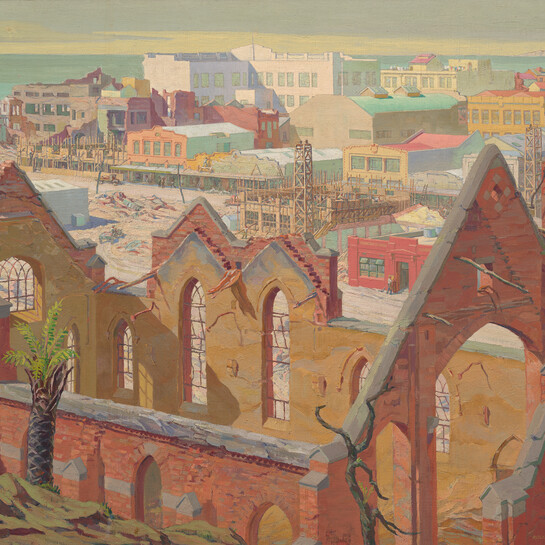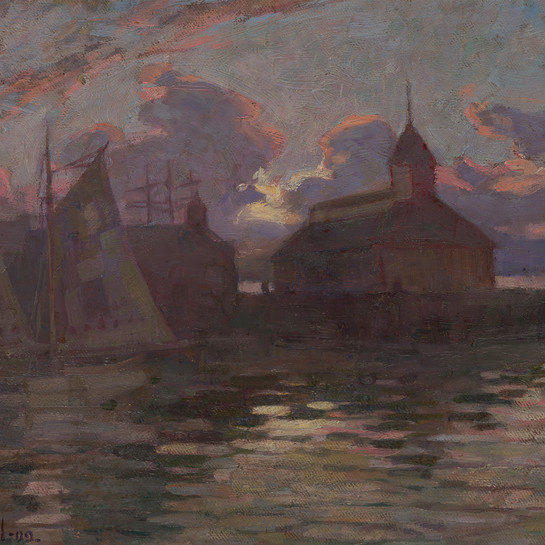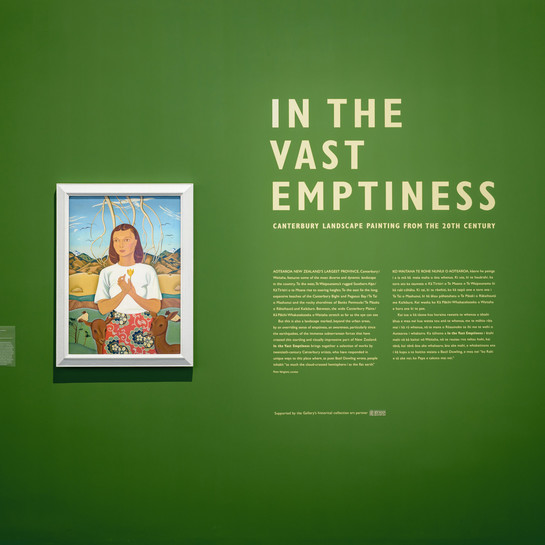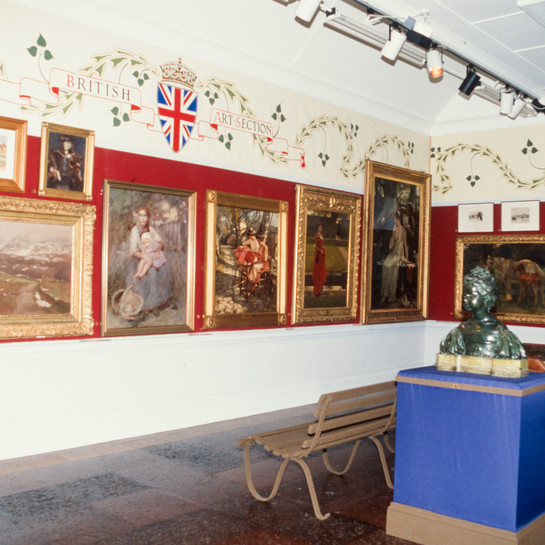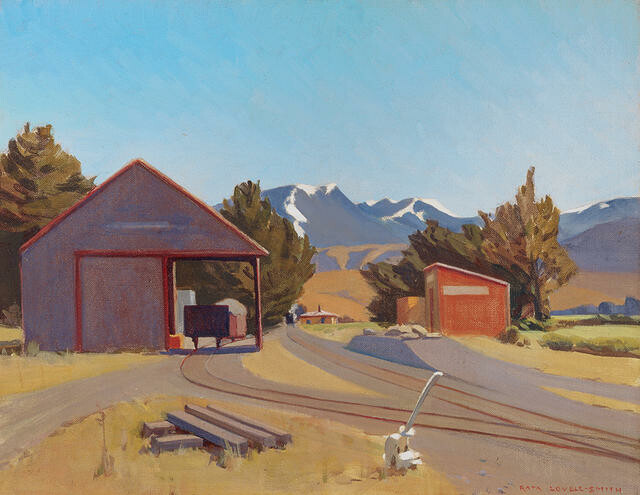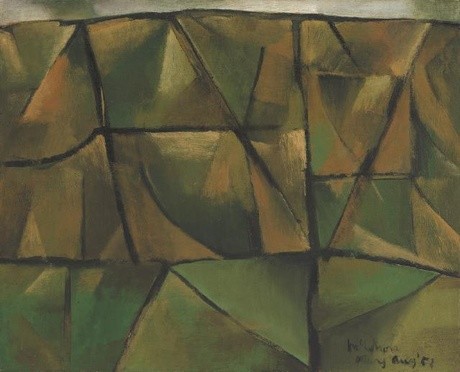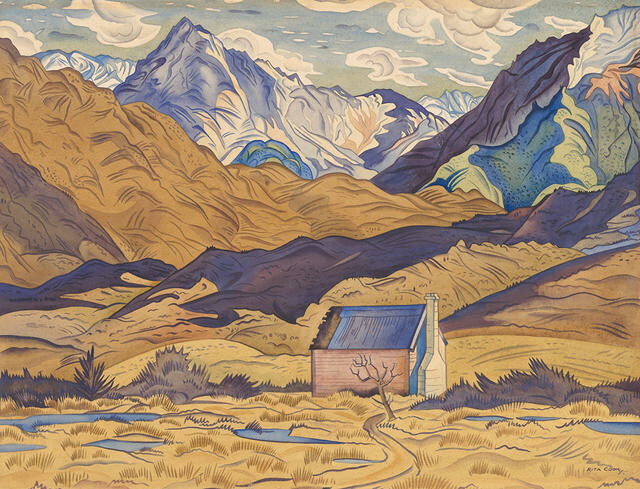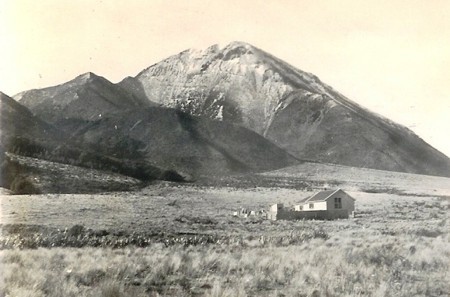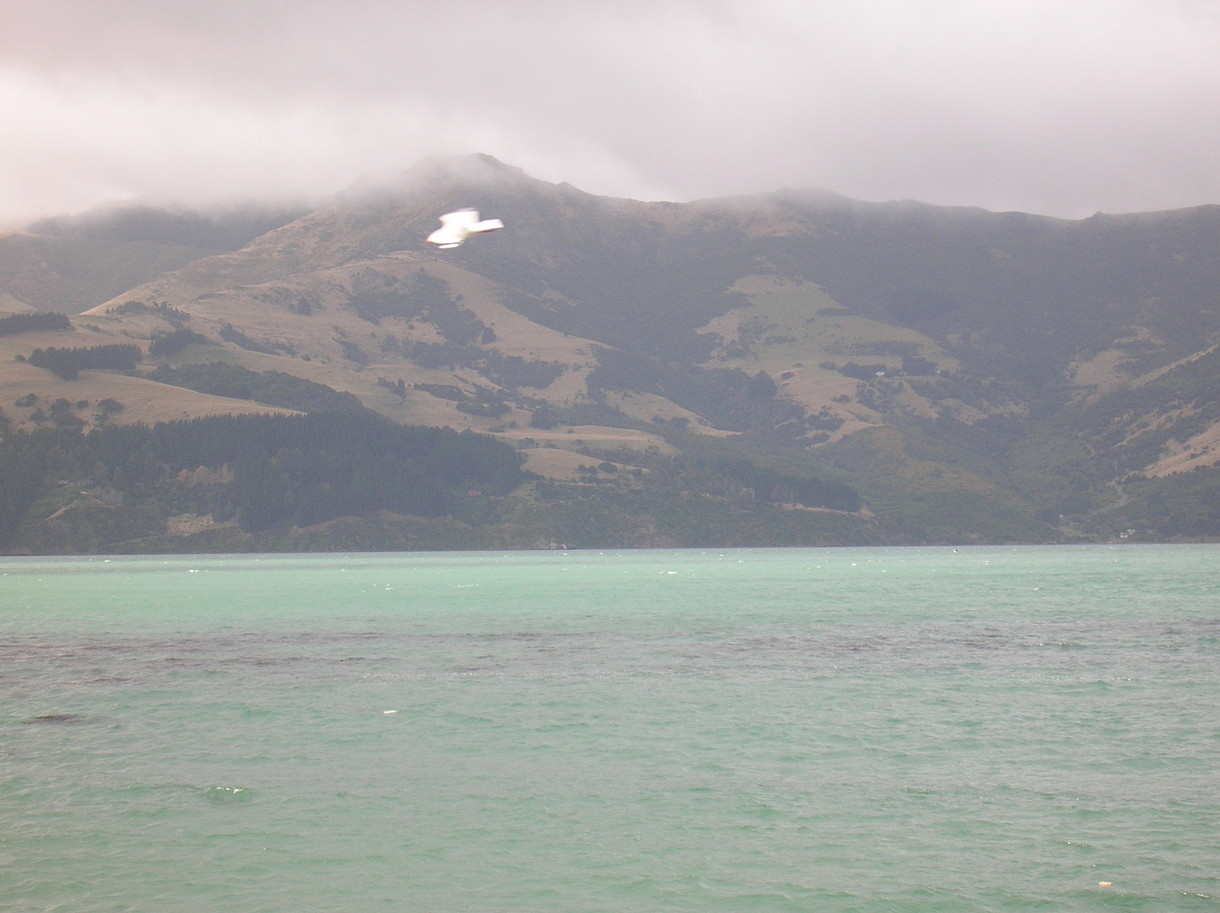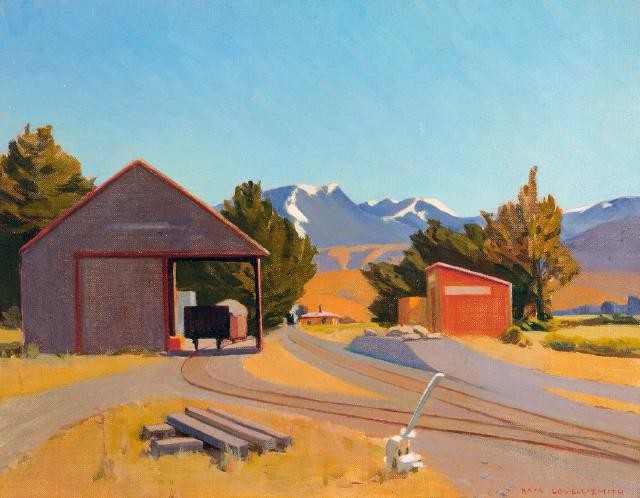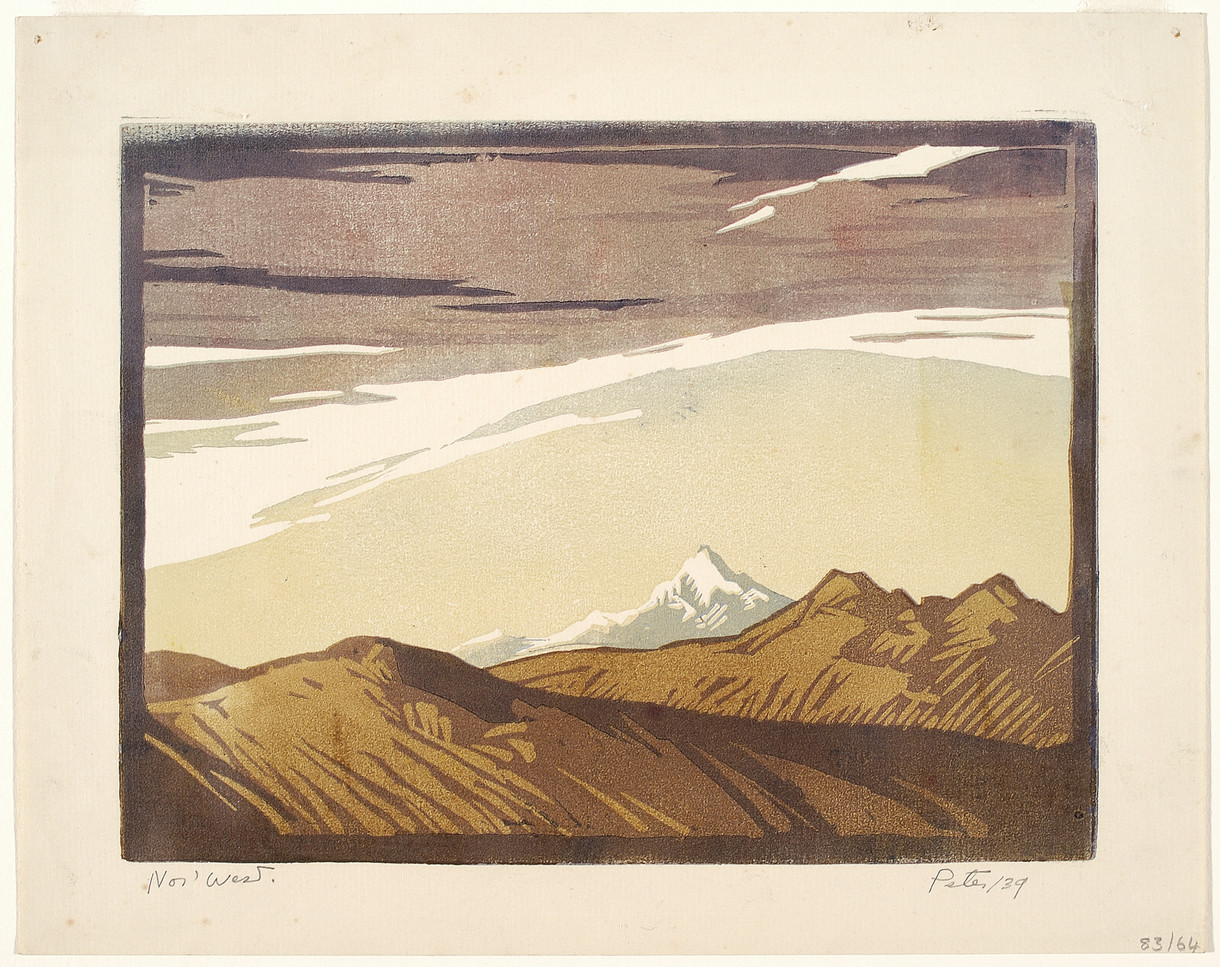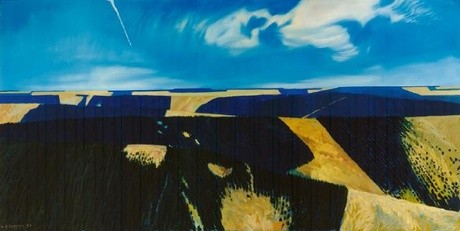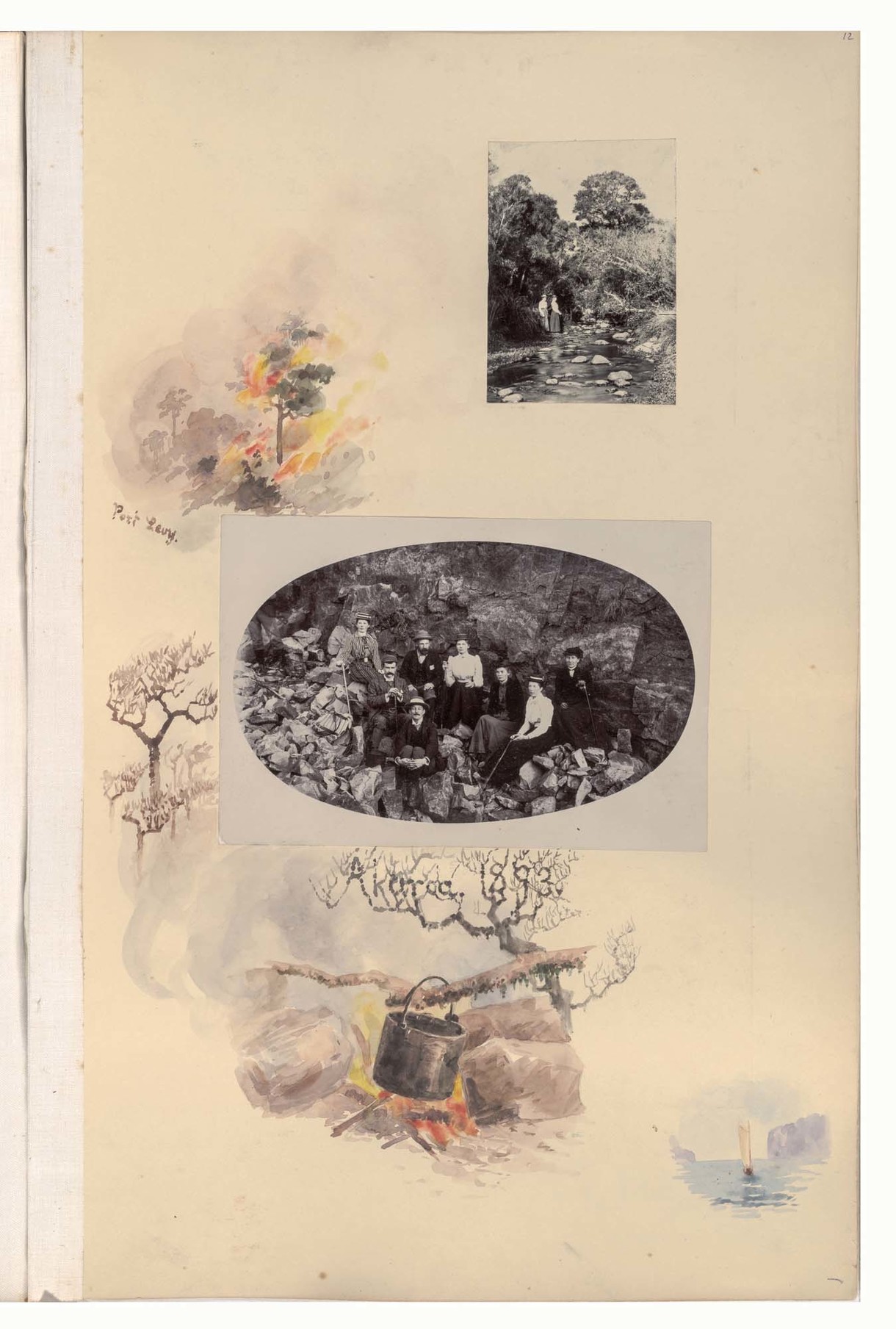Rata Lovell-Smith
Aotearoa New Zealand, b.1894, d.1969
Hawkins
- 1933
- Oil on canvas board
- Purchased 1981
- 345 x 450mm
- 81/33
- View on google maps
Location: Monica Richards Gallery
Tags: buildings (structures), freight cars, landscapes (representations), platforms (floors), railroad stations, snow (precipitation), sunlight, trees
A 1935 reviewer described Ōtautahi Christchurch-born Rata Lovell-Smith as “known for a simple and direct treatment of landscape [and] practically the pioneer in this way of seeing and representing the Canterbury countryside”.Lovell-Smith’s pared back approach appears at least partially inspired by contemporary British travel posters, an area of design studied at the Canterbury College School of Art where she trained and later taught. As demonstrated in Hawkins, the application of such an influence was effective in representing the hard, crisp light of rural Canterbury. This work also points to future works by others connected to the school, including Louise Henderson, Rita Angus, Ivy Fife and Russell Clark.
(From Here on the Ground, 18 May – 17 November 2024)
Exhibition History
Perilous, 6 August 2022 – 21 July 2024
The painting shows the railway station at Hawkins, a small farming settlement near Darfield. Rural stations like this were once a common feature on branch lines across the Canterbury Plains. Rata Lovell-Smith chose to paint outside, rather than in the studio, often seeking out isolated rural views. Her works vividly capture the region’s distinctive colours and bright, clear light, and her crisp style is especially well-suited to landscapes with strong structural elements. Here, she deftly conveys a scene full of lines, curves and angles while preserving a sense of the spaciousness of the mountains beyond and the open sky above.
Hawkins is a small farming settlement on the Whitecliffs branch railway line, five kilometres west of Darfield, on the Canterbury Plains. Rata Lovell-Smith shows it as a place of silence and isolation, with the empty buildings and railway lines the only signs of human activity. With the foothills and Southern Alps as a backdrop, the scene has a distinct sense of place. Lovell-Smith was one of the Canterbury School of artists whose members focused on the unique aspects of the Canterbury landscape, particularly the hard, sharp light of the region. They also simplified forms and objects within their compositions.
By the early 1930s Rata Lovell-Smith was highly regarded for this area of her practice. One Christchurch reviewer in 1933 commented:
'Of the painters who direct their attention towards the essential characteristics of New Zealand scenery […] Mrs Lovell-Smith makes an extremely direct statement of her subject. She paints with a large full brush in a series of broad planes. There is nothing 'bitty' about her work. This, perhaps, is its greatest virtue, a virtue that cannot be too highly praised. She glories in the colour contrasts of the New Zealand landscape. […] There are no subtleties but a series of vivid and simplified impressions of her native country. Whereas many pictures by [other] exhibitors […] might have been painted in other countries, there can never be any doubt about the locality of Mrs Lovell- Smith's landscapes. It is as though she had never got over her first impression of violent tone and colour contrasts, and in a state of beatific astonishment had set herself to establish that impression at the expense of anything that tended to modify it.'
(August 2020)
In 1930s New Zealand there was wide discussion about what was unique about the New Zealand situation; what it was that made us different from the rest of the world. Artists and writers began exploring ways to identify our national identity. A number of artists began painting the Canterbury High Country, most famously Rita Angus and her landscape painting of the railway station at Cass. One reviewer in 1936 observed that there was a new quality in the landscapes exhibited in Christchurch that seemed ‘to consist in a removal of the romantic mists which used to obscure mountains and the Canterbury countryside generally. The light now is clear and hard, the colours are in flat planes, and the effect is of seeing the country through a gem-like atmosphere. There is also a new romantic standpoint – an insistence on the isolation and brooding loneliness of the hills.’ It’s a statement that certainly rings true with the Canterbury paintings of Rita Angus, Leo Bensemann, Louise Henderson, Rata Lovell-Smith and Bill Sutton.
(March 2018)
In the vast emptiness, 8 January - 21 August 2016
By the early 1930s Rata Lovell-Smith was highly regarded for her paintings of the Canterbury landscape. One Christchurch reviewer in 1933 glowingly commented on her work:
'Of the painters who direct their attention towards the essential characteristics of New Zealand scenery […] Mrs Lovell-Smith makes an extremely direct statement of her subject. She paints with a large full brush in a series of broad planes. There is nothing 'bitty' about her work. This, perhaps, is its greatest virtue, a virtue that cannot be too highly praised. She glories in the colour contrasts of the New Zealand landscape. […] There are no subtleties but a series of vivid and simplified impressions of her native country. Whereas many pictures by [other] exhibitors […] might have been painted in other countries, there can never be any doubt about the locality of Mrs Lovell- Smith's landscapes. It is as though she had never got over her first impression of violent tone and colour contrasts, and in a state of beatific astonishment had set herself to establish that impression at the expense of anything that tended to modify it.'
Brought to light, November 2009- 22 February 2011
In the late 1920s Rata Lovell-Smith and her husband, fellow artist Colin Lovell-Smith, received criticism from more conservative members of Christchurch’s art community for painting in a style that was considered too poster-like. Paintings such as ‘Hawkin’s and ‘Bridge, Mt Cook road’ emphasise human structures in the landscape rather than avoiding them. The unadorned angular structures of the small station and goods shed at Hawkins have been simplified into bold planes in an approach that concentrates more on compositional design than on texture or naturalism. Rata Lovell-Smith’s work is the forerunner of a regionalist style that influenced later Canterbury painters including Rita Angus, Louise Henderson, Doris Lusk and William Sutton.
Hawkins is a small farming settlement on the Whitecliffs branch railway line, five kilometres west of Darfield, on the Canterbury Plains. Rata Lovell-Smith shows it as a place of silence and isolation, with the empty buildings and railway lines the only signs of human activity. With the foothills and Southern Alps as a backdrop, the scene has a distinct sense of place. Lovell-Smith was one of the Canterbury School of artists whose members focused on the unique aspects of the Canterbury landscape, particularly the hard, sharp light of the region. They also simplified forms and objects within their compositions.
Born in Christchurch, Lovell-Smith (née Bird) studied at the Canterbury College School of Art from 1911 to 1912 and trained as a teacher. She exhibited at the Canterbury Society of Arts from 1924 to 1966 and taught at the School of Art from 1924 to 1945. From 1935 Lovell-Smith was also a regular exhibitor with The Group. In 1939 she won the Bledisloe Medal for New Zealand landscape painting for her work Bush Scene. (Opening Gallery hang, 2003)
The subject of this work, the railway station and yards at Hawkins, is at a small farming locality on the Whitecliff Line five kilometres west of Darfield. Small railway stations such as this were once a common feature on branch lines in Canterbury.
The painter Rata Lovell-Smith (née Bird) was born in Christchurch, and trained at Canterbury College School of Art where she later taught until 1945.
In the 1920s and 1930s both she and her artist husband, Colin Lovell-Smith, painted Canterbury landscapes in a style that relied on structuring the subject in bold planes and areas of colour, throwing greater emphasis on design than naturalism. Hawkins, like many of Rata Lovell-Smith’s works of the time, drew criticism from traditionalists who considered her style too ‘poster-like’. Also, the taking of a subject such as a railway station as a major motif was rare in New Zealand painting. (Label date unknown, before 2003)
